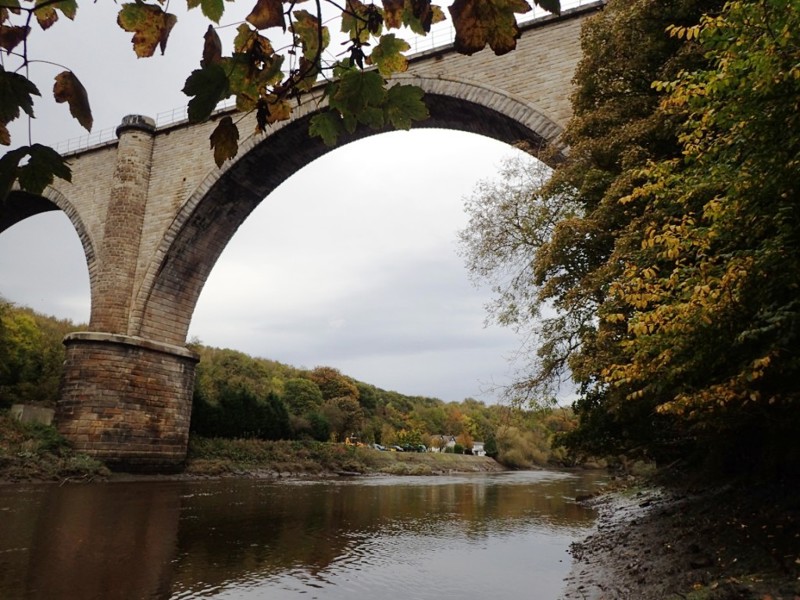Daryl Aulsberry is currently a STE4 and STE7 Structures Examiner at Amey on the London North Eastern (LNE) route.
“I’ve been at Amey for almost seven years, after relocating from the East Midlands to Teesside with my wife and young children. With Amey being the principal contractor for the entirety of the LNE route, I could work predominantly close to home, to spend time with my family.
“I first started as a trainee almost 13 years ago and have always enjoyed the varied work that a Structures Examiner undertakes – no two days are the same. A day on site completing underwater examinations can involve assessing a variety of structures; from culverts to retaining walls, to bridges and viaducts.
“To undertake these exams in a tactile manner we must enter the water; this can be crawling through streams, wading through streams or shallow rivers and swimming across canals and deep rivers. The exam itself involves both undertaking a bed profile survey of the watercourse bed and a condition inspection of both the structure and the watercourse, including how the two interact.
“I’ll collate all of the site information from my tablet into a thorough technical report, including text, sketches, photographs, spreadsheets and graphs to give the client team at Network Rail an accurate picture of the condition of the asset. We work collaboratively with Network Rail to review the full data set and resulting recommendations, so any decisions made are sympathetic to the structure and the safest option for customers.”
Proactive asset management
While many of the structures have been in existence for many years, the proactive examination schedule makes sure they’re kept fit for purpose. Early identification of any defects and routine monitoring prevents potential problems escalating.
“Each exam will have site-specific Task Briefing Sheet created which is used during our on-site dynamic risk assessment when deciding the safest and most efficient way to undertake the underwater exam. All relevant previous exam reports are sourced and taken to site, to allow us to assess the site conditions and to gauge the extent of any deterioration in the condition of the structure and / or the watercourse.
“I’ll also review whether any third party access requires pre-arranging, whether any track access is required, whether any permits are required to enter the watercourse, whether the watercourse is tidal and therefore the best time of day to undertake the exam, if the exam needs to be undertaken at a certain time of year due to flooding, whether any isolations are required an any manually controlled watercourses or even whether any boat traffic may be present.
“At Amey we undertake the ‘simple’ underwater exams in-house. For the more complex underwater exams requiring more than man access, such as a safety boat and / or diving operations, we work with our specialist contractors.
“And while the public are unlikely to notice our work, I’m always proud when I arrive on-site to realise that scour protection or prevention works have been undertaken as a result of one of our previous underwater exam reports. Scour is one of the leading causes of bridge failures so early identification and mitigation helps to reduce the potential impact on rail passengers of a line closure.”
Complex structures, specialist solutions
Railway structures can be incredibly beautiful but are also highly complex. Often located in challenging, sometimes inaccessible, places, they are engineering feats of the 19th and 20th centuries, which require specialist attention to protect and preserve. Amey’s Structures Examiners are highly trained to be sympathetic to the structures and adaptable to difficult working conditions. Daryl takes all of this in his stride.
“I enjoy undertaking underwater exams as it’s a change from the conventional detailed, visual and line of route exams. It’s definitely more enjoyable getting in the water in the summer months though!
“Our PPE includes dry suits which have been modified to have steel toe caps and steel midsoles; these not only keep us dry but also act as a buoyancy aid. Our remaining PPE consists of a hi-vis vest, a fitted hard hat, waterproof gloves and a waterproof hood. We use survey equipment to allow us to undertake watercourse bed profile surveys, this can include distometers, datum poles, telescopic measurement staffs and sonar measuring equipment. For our condition inspection we use hand tools, including short tape measures, long tape measures, inspection hammers, chalk and good, old pencil and paper.
“The most unusual thing about underwater exams which others may not know is that, for the vast majority, no person(s) are required to actually become fully submerged under the water, with only a small percentage actually requiring dive operations. This is because, for the vast majority of exams, the interaction between the structure and watercourse can be fully examined using hand tools and survey equipment.
“I’d like those reading to understand a little more about the unseen role of a Structures Examiner. I’m still impressed by the structures across the UK, and I’d pick the Victoria Viaduct – an 11No span viaduct with an extremely deep and fast flowing tide – as one of the highlights of my role.”
